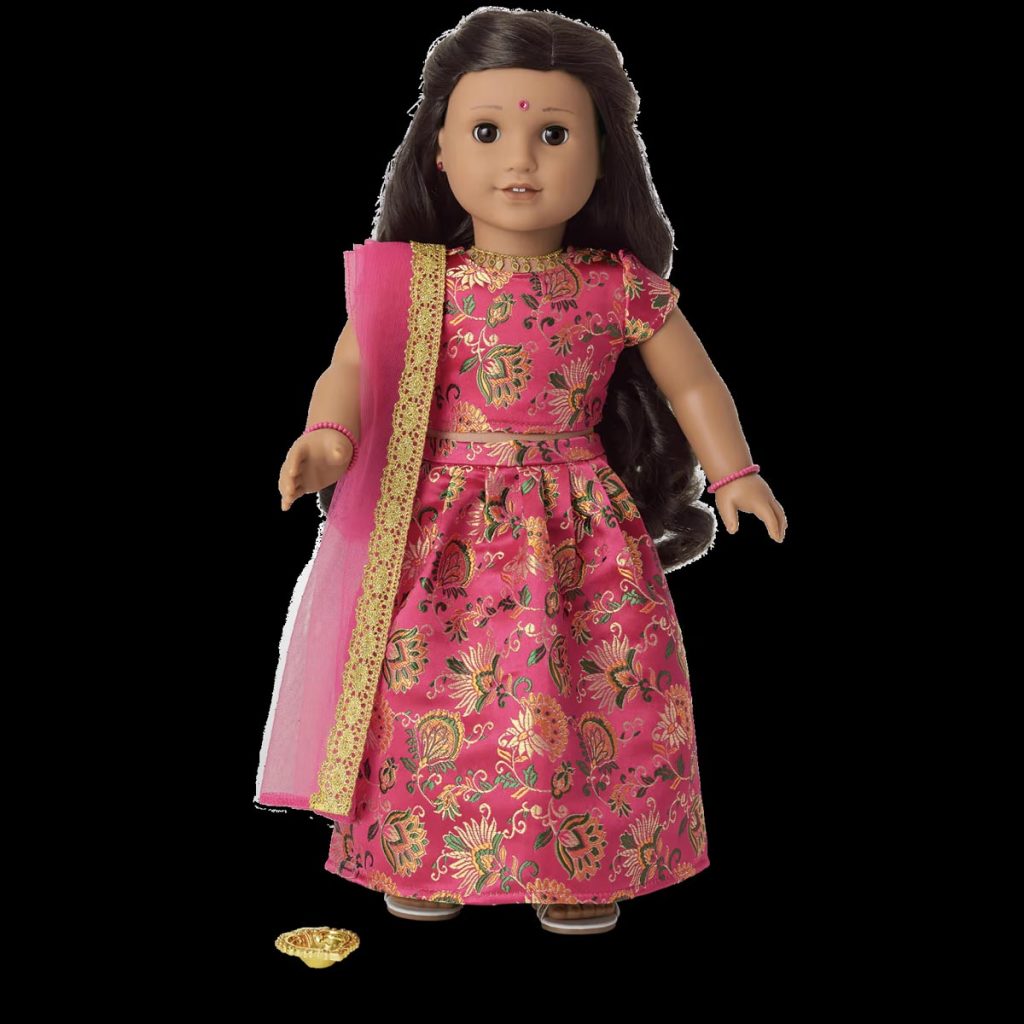By Sanjeevani Dedge and Mugdha Shinde, California
Each year, a long, thoughtful process takes place to create the American Girl of the Year doll. These limited-edition wonders are meant to be more than just simple dolls. They have complex back stories, dreams and passions, and are created to reflect the life of a typical American girl in the given year. In January, American Girl announced their 2023 Girl of the Year: Kavi Sharma.
Girl of the Year focuses on cultural diversity. Last year’s was Corinne Tan, the first-ever Asian American Girl of the Year. The company’s press release stated, “Kavi joins the company’s long line of contemporary characters, introduced more than 20 years ago, that represent a wide range of backgrounds to reflect what it means to be an American girl today.”
On the American Girl website, we see that Kavi is an Indian-American Hindu living in New Jersey. Her description says, “Kavi loves performing, but can she find a way to stay on top of her schoolwork and get her dance moves down before the curtain goes up?” At Hinduism Today’s request, the two of us studied the new doll and consulted with friends and family to create this review.
Overview
Kavi, just like other American Girl dolls, is expensive. The doll itself with a journal telling her story costs $155, plus there are many outfits and accessories that consumers can buy. These include her dog ($34), songwriting accessories ($115), yoga accessories ($30), and a backstage trunk ($125). There are also multiple costumes, such as Kavi’s performance outfit, pajamas, and her yoga attire, each costing $30-45. Her Bollywood dance costume ($45) is the accessory we think is most significant. This is the costume she wears at the end of the journal while performing with her friends. It is also worn by dancers in a video performance during the American Girl Reveal for Doll of the Year. What we really appreciated about this outfit is that it comes with not only Indian jewelry for Kavi, but also a mini packet of bindis—a nice addition.


As the bindis show, it is essential to acknowledge how American Girl does not shy away from expressing Kavi’s Hindu identity as part of her story. They boldly depict Kavi as Hindu by including Hindu festivals, dances and bindis in her accompanying journal.
The journal, written from Kavi’s perspective, revolves around a big dance performance that she and her friends are working to prepare by the end of the month. However, they cannot agree on what type of dance they want to do. Kavi has to figure out how to balance her schoolwork while coming up with a dance they can all agree on.
Speaking of dance—that art form is a big part of Kavi’s backstory. The whole marketing campaign for Kavi is based on her love of performing, and several types of Indian and Western dance styles are included in the journal. These include Kathak, Hip-Hop, and finally Bollywood dance, which is shown to be a way for Kavi to combine her Indian roots and American upbringing.
The Attention to Detail
American Girl worked with Arusha, a 12-year-old Indian-American dancer, and Rina Shah, owner of Aum Dance Creations. This clearly shows their effort to not only correctly represent Indian dance but to get a full understanding of what Kavi’s life might look like as an Indian American tween.

American Girl continues to show this attention to details throughout the journal. There are many references to Indian/Hindu things that are a part of Kavi’s life, for example, her good-luck elephant charm that she named Haathi. Haathi is the word for elephant in Hindi, and the journal mentions that elephants symbolize wisdom in Hindu culture (a subtle nod to Lord Ganesha). Further, Kavi’s grandma is shown wearing a sari and bindi to attend a performance of Broadway’s “Wicked.”
Another great aspect of the doll is the name: Kavi. It is a uniquely Indian name, and also quite clever and well-thought out, as kavi means “poet” in Sanskrit, and writing is one of her hobbies.
American Girl does a great job not only by featuring Diwali in the journal, but also by noting the specific five days of the festival. Often, the media’s representation of Diwali only focuses on one day or explains what the festival is as a whole. It is clear that American Girl did their research. They included a description of what Kavi did each day: a day for cleaning, decorating the house with diya lamps, a day to eat vegetarian food, a gift exchange day, and finally a day to visit family and watch fireworks.
The descriptions of the days are accurate, but including the names of the days would have further elaborated the Hindu aspect. And it is strange that the reason for celebrating Diwali was not included. They also failed to mention Ram’s coming home to Ayodhya, which is a very significant part of the festival for most Hindu families.
A novel to be released describes Kavi celebrating Holi, which is a nice addition. Hopefully there will be some mention of Holika or other key elements that give meaning to the celebration of that festival.

Room for Improvement
Near the end of the journal Kavi goes to a yoga class with her dad, and she writes about her great experience, “Yoga did calm my mind. Afterward I felt amazingly relaxed.” It is also nice how in a poster with yoga poses Kavi gets from the class it says “Yoga Asanas,” with the explanation that asanas means “poses.” At the end of the book there are images and instructions for various yoga asanas for the reader to try out. We think they should have provided the Sanskrit names for the asanas along with the English names. For example “downward dog” could also have also been written as adho mukha svanasana. Given the attention to detail in the rest of the journal, including the names of the asanas was expected.
Another opportunity for improvement would be mentioning Kavi’s practice of Hinduism. There are multiple illustrations of her wearing a bindi and her explaining how she celebrates Diwali, but she never talks about how the religion connects to her.
A big part of any religion is its God(s), and Hinduism is well known for having several Gods, both male and female. Thus, it is a bit surprising that there is no mention of Gods or details on how Kavi worships. This was especially apparent in the Diwali part of the journal, which doesn’t include the religious activities that take place during the festival. American Girl could have noted that it is common for Hindus to pray at least once a day in their home, especially during festivals. A temple should also have been mentioned in the journal, along with the yoga studio and Broadway theater, as being an important part of Kavi’s life.
Varying Reactions
Gargi Dedge, an Indian-American fifth grader, the target audience for Kavi, told us, “I’m so happy to see that there’s an American Girl doll that’s just like me! She is Indian American, Hindu, and she does Kathak—I do Bharatnatyam. I also liked seeing that she celebrated Diwali, because I and my family do too. I think this doll will make many girls like me feel included.”
We also asked a Hindu parent living in the US, Forum Dhulekar, how she felt about Kavi. Her thoughts were, “Introducing a different ethnicity does support diversification of its customer base. However, I feel the American Girl doll is not truly representing India as a whole. In terms of improvement, they can introduce more friends representing different parts of India, and different festivals. Yes, Diwali is synonymous to India and Indians, but there is more to India.”
Aditi, a 9th grader, said, “I do not think it is a good representation of Indian-Americans in the US, because it seems to follow all the stereotypical things that many people associate with Indians in general. It talks about her taking advanced courses and struggling to get good grades to please her parents, which is something that many students struggle with and is often harmful to their mental health. It may do its part in encouraging young students to follow their dreams, but it may also pressure kids to live up to the insane expectations that are set for them.” This is an interesting point that is undoubtedly important to address.
Conclusion
These reactions make us wish we had a doll like Kavi when we were younger. Growing up, we’d only seen and bought mostly white dolls, and if they were any other race, they were usually Black, Hispanic, rarely East Asian, but never Indian. We’re so happy that other young Indian American girls are getting an opportunity we never got.
While we think that while there is some room for improvement in terms of the Hindu aspects of her life, the doll will definitely make young Indian American girls feel included and represented. All in all, Kavi is undoubtedly a step in the right direction for a more Hindu-friendly culture in the US.
About the authors

Sanjeevani Dedge (left, with newly arrived Kavi) was born in Santa Clara, California, and lives in San Jose. Now a 9th-grade student at Dartmouth Middle School, she enjoys dance, swimming and wrestling. sanjeevanisdedge@gmail.com
Mugdha Shinde, (right) 15, is an 9th-grade student at Cupertino Middle School in Cupertino, California. She plays the trombone in her school’s band and enjoys cooking and baking. mugdha.shinde29@gmail.com
